(完整版)人教版高中英语必修三情态动词基本用法
- 格式:ppt
- 大小:342.51 KB
- 文档页数:31
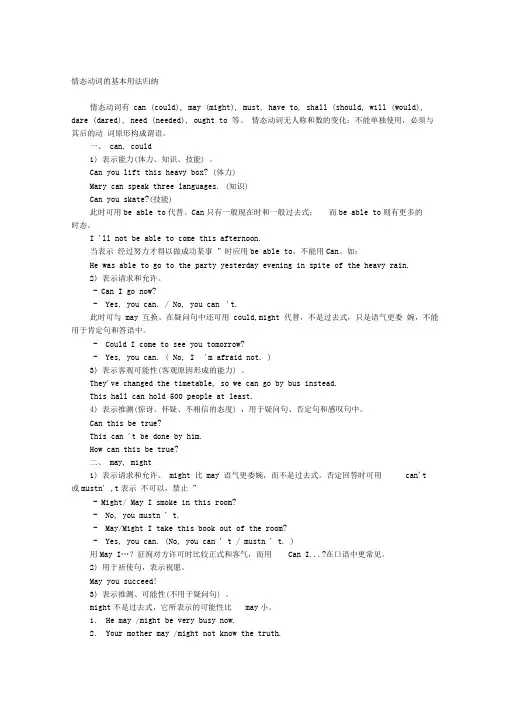
情态动词的基本用法归纳情态动词有can (could), may (might), must, have to, shall (should, will (would), dare (dared), need (needed), ought to 等。
情态动词无人称和数的变化;不能单独使用,必须与其后的动词原形构成谓语。
一、can, could1)表示能力(体力、知识、技能) 。
Can you lift this heavy box? (体力)Mary can speak three languages. (知识)Can you skate?(技能)此时可用be able to代替。
Can只有一般现在时和一般过去式;而be able to则有更多的时态。
I 'll not be able to come this afternoon.当表示经过努力才得以做成功某事”时应用be able to,不能用Can。
如:He was able to go to the party yesterday evening in spite of the heavy rain.2)表示请求和允许。
- Can I go now?- Yes, you can. / No, you can 't.此时可与may 互换。
在疑问句中还可用could,might 代替,不是过去式,只是语气更委婉,不能用于肯定句和答语中。
- Could I come to see you tomorrow?- Yes, you can. ( No, I 'm afraid not. )3)表示客观可能性(客观原因形成的能力) 。
They've changed the timetable, so we can go by bus instead.This hall can hold 500 people at least.4)表示推测(惊讶、怀疑、不相信的态度) ,用于疑问句、否定句和感叹句中。
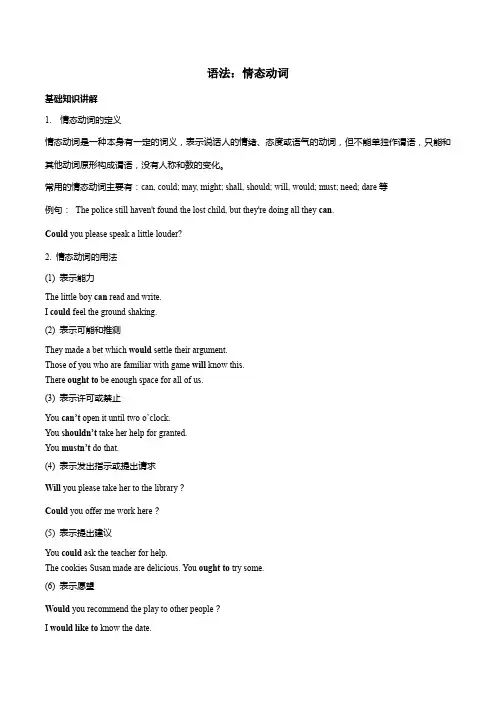
语法:情态动词基础知识讲解1. 情态动词的定义情态动词是一种本身有一定的词义,表示说话人的情绪、态度或语气的动词,但不能单独作谓语,只能和其他动词原形构成谓语,没有人称和数的变化。
常用的情态动词主要有:can, could; may, might; shall, should; will, would; must; need; dare等例句:The police still haven't found the lost child, but they're doing all they can.Could you please speak a little louder?2. 情态动词的用法(1) 表示能力The little boy can read and write.I could feel the ground shaking.(2) 表示可能和推测They made a bet which would settle their argument.Those of you who are familiar with game will know this.There ought to be enough space for all of us.(3) 表示许可或禁止You can’t open it until two o’clock.You shouldn’t take her help for granted.You mustn’t do that.(4) 表示发出指示或提出请求Will you please take her to the library?Could you offer me work here?(5) 表示提出建议You could ask the teacher for help.The cookies Susan made are delicious. You ought to try some.(6) 表示愿望Would you recommend the play to other people?I would like to know the date.(7) 表示义务和需要You must come at once.We have to wear uniforms at school.【过关检测】单项选择1.【★★★】—Mary knows the city quite well.—She______ well have been there before.A.need B.could C.should D.may【答案】D【解析】考查情态动词辨析。
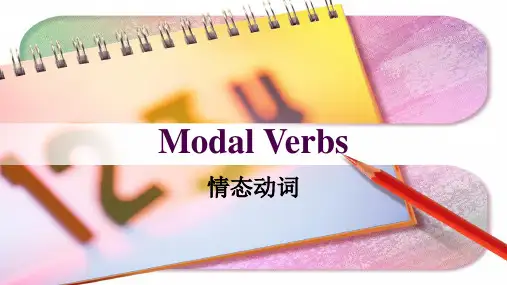
![新人教必修3_Unit1_Grammar情态动词]](https://uimg.taocdn.com/35b7c822453610661ed9f4a7.webp)
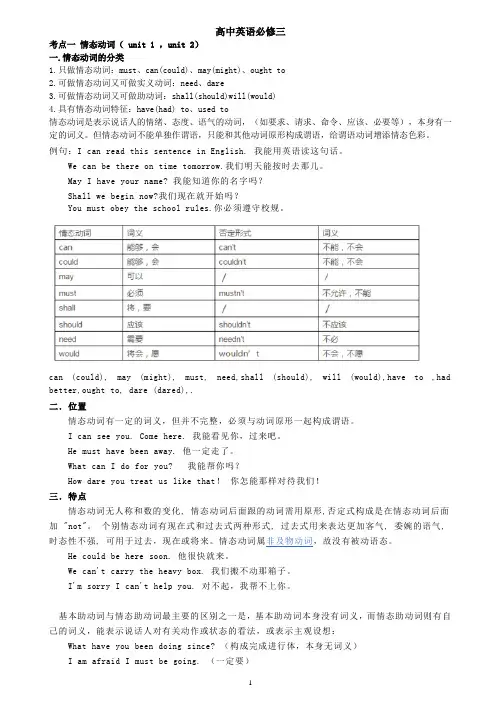
高中英语必修三考点一情态动词( unit 1 ,unit 2)一.情态动词的分类1.只做情态动词:must、can(could)、may(might)、ought to2.可做情态动词又可做实义动词:need、dare3.可做情态动词又可做助动词:shall(should)will(would)4.具有情态动词特征:have(had) to、used to情态动词是表示说话人的情绪、态度、语气的动词,(如要求、请求、命令、应该、必要等),本身有一定的词义。
但情态动词不能单独作谓语,只能和其他动词原形构成谓语,给谓语动词增添情态色彩。
例句:I can read this sentence in English. 我能用英语读这句话。
We can be there on time tomorrow.我们明天能按时去那儿。
May I have your name? 我能知道你的名字吗?Shall we begin now?我们现在就开始吗?You must obey the school rules.你必须遵守校规。
can (could), may (might), must, need,shall (should), will (would),have to ,had better,ought to, dare (dared),.二.位置情态动词有一定的词义,但并不完整,必须与动词原形一起构成谓语。
I can see you. Come here. 我能看见你,过来吧。
He must have been away. 他一定走了。
What can I do for you? 我能帮你吗?How dare you treat us like that!你怎能那样对待我们!三.特点情态动词无人称和数的变化, 情态动词后面跟的动词需用原形,否定式构成是在情态动词后面加 "not"。
个别情态动词有现在式和过去式两种形式, 过去式用来表达更加客气, 委婉的语气, 时态性不强, 可用于过去,现在或将来。

人教版高中英语必修三语法总结高中英语必修三语法主要考点有情态动词、名词性从句、同位语从句等,下面是具体的高中英语必修三语法,仅供参考。
1英语必修三有哪些语法要学考点一情态动词(unit1,unit2)一、情态动词的特点:1.没有人称和数的变化。
2.有些情态动词有过去式的变化:e.g.will→would,can→could,may→might,dare→dared二、情态动词的否定式:情态动词+not+动词原形cannot:can’t,mustnot:mustn’t,neednot:needn’t三、情态动词的用法及相互区别,是考试的内容之一1.can,beabletobeableto表示经过努力后,能够做到;beableto有多种形式的变化。
can1).表示体力或脑力方面的能力;2).表示允许、可能性。
could是can的过去式,表示过去有能力及过去存在的可能性;用于疑问句表示委婉地提出问题。
1)Thefirespreadthroughthehotelveryquicklybuteveryone____getout.(NMET97)A.hadtoB.wouldC.couldD.wasableto2)-Willyoustayforlunch?-Sorry,__.Mybrotheriscomingtoseeme.(NMET99)A.Imustn’tB.Ican’tC.Ineedn’tD.Iwon’t2.may表示询问或说明一件事可不可做;表示某事有可能发生。
might是may的过去式;用在疑问中比may委婉、客气。
1)-MayItakethisbookoutofthereading-room?-No,youmustn’t.(Yes,youmay.)2)-MightImakeasuggestion?-Yes,youmay.3.must1).表示必须要做的事:必须2)表示很有把握的推断:一定,准是。
have(has)to:have(has)gotto必须,不得不。
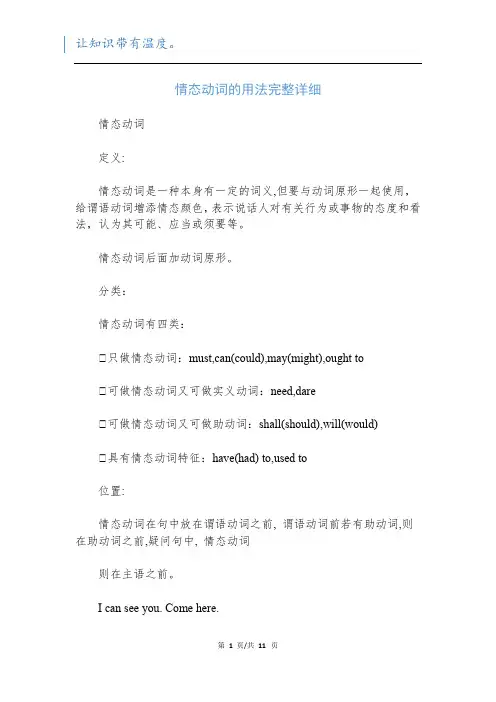
情态动词的用法完整详细情态动词定义:情态动词是一种本身有一定的词义,但要与动词原形一起使用,给谓语动词增添情态颜色,表示说话人对有关行为或事物的态度和看法,认为其可能、应当或须要等。
情态动词后面加动词原形。
分类:情态动词有四类:①只做情态动词:must,can(could),may(might),ought to①可做情态动词又可做实义动词:need,dare①可做情态动词又可做助动词:shall(should),will(would)①具有情态动词特征:have(had) to,used to位置:情态动词在句中放在谓语动词之前, 谓语动词前若有助动词,则在助动词之前,疑问句中, 情态动词则在主语之前。
I can see you. Come here.我能看见你,过来吧。
He must have been away.他一定走了。
What can I do for you?我能帮你吗?How dare you treat us like that!你怎能那样对待我们!特点:情态动词无人称和数的变化, 情态动词后面跟的动词需用原形,否定式构成是在情态动词后面加"not"。
个别情态动词有现在式和过去式两种形式, 过去式用来表达越发客气, 委婉的语气, 时态性不强, 可用于过去,现在或未来。
情态动词属非及物动词,故没有被动语态。
情态动词没有非谓语形式,即没有不定式,分词,等形式。
He could be here soon.他很快就来。
We can't carry the heavy box.我们搬不动那箱子。
I'm sorry I can't help you.对不起,我帮不上你。
基本助动词与情态助动词最主要的区分之一是,基本助动词本身没有词义,而情态助动词则有自己的词义,能表示说话人对有关动作或状态的看法,或表示主观设想:What have you been doing since? (构成完成举行体,本身无词义)I am afraid I must be going. (一定要)You may have read some account of the matter. (或许已经)除此之外,情态助动词还有如下词法和句法特征:1)除ought和used以外,其他情态动词后面只能接不带to的不定式。

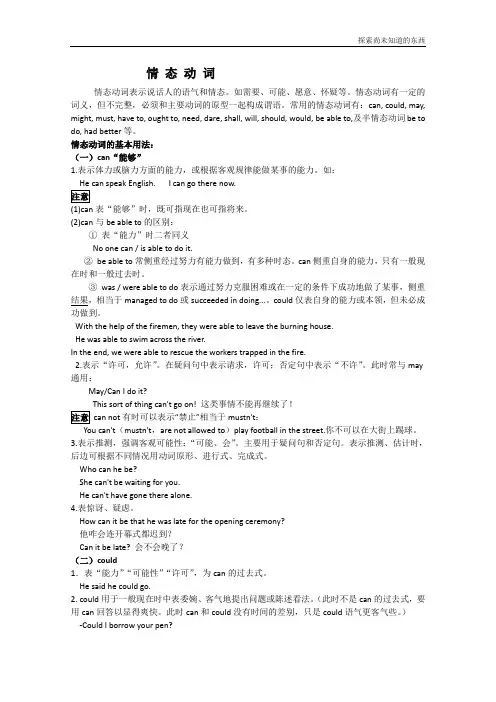
情态动词情态动词表示说话人的语气和情态。
如需要、可能、愿意、怀疑等。
情态动词有一定的词义,但不完整,必须和主要动词的原型一起构成谓语。
常用的情态动词有:can, could, may, might, must, have to, ought to, need, dare, shall, will, should, would, be able to,及半情态动词be to do, had better等。
情态动词的基本用法:(一)can“能够”1.表示体力或脑力方面的能力,或根据客观规律能做某事的能力。
如:I can go there now.(1)can表“能够”时,既可指现在也可指将来。
(2)can与be able to的区别:①表“能力”时二者同义No one can / is able to do it.②be able to常侧重经过努力有能力做到,有多种时态。
can侧重自身的能力,只有一般现在时和一般过去时。
③was / were able to do表示通过努力克服困难或在一定的条件下成功地做了某事,侧重结果,相当于managed to do或succeeded in doing...。
could仅表自身的能力或本领,但未必成功做到。
With the help of the firemen, they were able to leave the burning house.He was able to swim across the river.In the end, we were able to rescue the workers trapped in the fire.2.表示“许可,允许”。
在疑问句中表示请求,许可;否定句中表示“不许”。
此时常与may 通用:May/Can I do it?This sort of thing can't go on! 这类事情不能再继续了!can not有时可以表示“禁止”相当于mustn't:You can't(mustn't,are not allowed to)play football in the street.你不可以在大街上踢球。
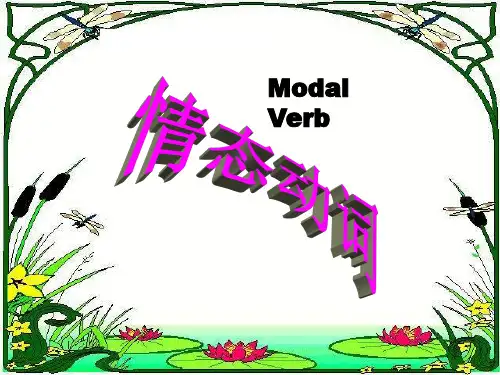
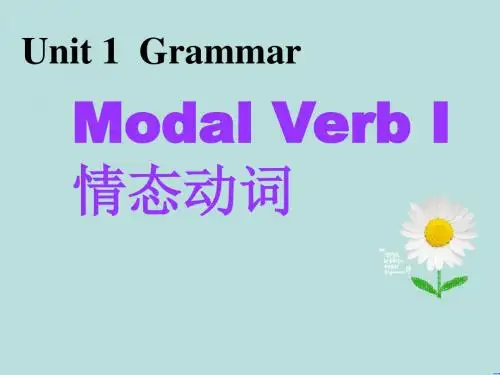
Book 3 Unit 1 Festivals around the world高考常考情态动词的基本用法总结:can1) 能力Mary can speak three foreign languages.玛丽能说三门外语。
注意:can只能表示现在的能力,could表示过去的能力,be able to do可以表示现在、将来和过去的能力,am/is /are able to do ,will be able to do,was/ were able to docould表示过去的能力,不表示是否做was/ were able to do 表示过去有能力做并且成功做了Tom could swim at the age of nine.could(过去的能力,不表是否做)汤姆在九岁就能游泳。
The fire spread through the hotel very quickly but everyone was able to get out .( was able to过去有能力做,并且成功做了)was able to 在本句相当于manage to do /succeeded to do尽管这场大火迅速蔓延到了整个宾馆,但是每个人都逃了出去。
2)许可/允许--Can /Could(表委婉/客气) I use your pen?我可以用一下你的钢笔吗?--Yes, you can.(回答只能用can)--No, I’m afraid not.3)可能(在否定句和疑问句中表示具体发生的可能性,在肯定句中表示理论上的可能性)--Can it be true ?那事可能是真的吗?--It can’t be true.它不可能是真(具体发生的可能性Harvest and Thanksgiving festival can be very happy events.(理论上的可能性)收获节和感恩节可能是非常喜庆的节日。
Unit2 单元语法详解情态动词(I)情态动词的基本用法常见的表示推测含义的情态动词主要有must, can/could, may/might等。
1. 在肯定句中表推测肯定句中用must(一定;肯定),could(可能),may/might(也许;或许)表推测。
must 表示“肯定. . . . . . ”,could/may/might 表不“可能. . . . . . ”。
(1)表示对现在或将来的推测,用“must/could /may/might+动词原形”结构。
You must be hungry Have something to eat.你一定饿了,吃些东西吧。
Anna may know Tom’s address.安娜可能知道汤姆的地址。
I guess he might come tomorrow.我猜他明天可能来。
(2)表示对过去的推测,用“must/may/might/could+have done”结构。
I didn’t hear the phone. I must have been asleep.我没听到电话响,我一定是睡着了。
Tom isn’t in the classroom. He may/might/could have gone to the library.汤姆没在教室里,他也许/可能到图书馆去了。
(3)表示对正在发生的事情的推测,用“ must/may/might/could + be doing”结构。
It’s 11 pm. Tom must be watching the football match now.现在是晚上十一点,汤姆肯定正在看球赛。
例1单句填空——I am sure I saw Brian in the park this morning.——You be imagining things. He left for America last night.解析考查情态动词。
高中英语必修三Unit 5语法汇总一、过去将来时1.过去将来时表示从过去某一时间来看将要发生的动作或存在的状态,常用在宾语从句中。
一般由“would/should+动词原形”构成。
*She hoped thatthey would meet again someday.她希望将来有一天他们能再见面。
*I rang up to tellmy father that I should leave for London.我打电话告诉我父亲我要去伦敦。
2.was/were goingto+动词原形:表示过去将要发生或很有可能发生的动作,常用于口语中,表示预言、意图或者打算等。
*He was going tostart work the following week.他打算下星期开始工作。
*—Alice, whydidn’t you come yesterday?——爱丽丝,你昨天为什么没来呀?—I was going to,but I had an unexpected visitor.——我打算去的,但我家来了个不速之客。
3.start, go,come, leave, see, meet等动词的过去进行时: 表示就过去某一时刻而言即将发生的动作。
*She was cominglater.她随后就来。
*I had just put onmy overcoat and was leaving to visit a friend of mine.我刚穿上外套要去看我的一个朋友。
4.was/were aboutto do: 常用来表示即将发生的动作,“刚要/正要做……”。
注意该结构不与任何时间状语连用。
*I felt thatsomething terrible was about to happen.我感到某种可怕的事情即将发生。
*We were about togo there when it began to rain.我们刚打算去那儿,这时天下起了雨。
助动词与情态助动词情态助动词与基本助动词的最主要区别之一是, 基本助动词没有词汇意义,而情态助动词则有自己的词汇意义, 能表示说话人对所说话语的态度和看法, 或表示主观设想及其他情态意义。
【情态助动词的词法和句法特征】一、后面只接动词原形。
(ought to、used to可以被看作是固定词组);二、没有非限定形式,即没有不定式、ing分词或ed分词等形式。
三、第三人称单数现在时没有词形变化,即没有-s形式。
四、“时态”并不是时间区别的主要标志。
在不少场合,情态助动词的现在时形式和过去时形式都可用来表示现在时间、过去时间或将来时间。
【哪些词是情态助动词?】情态助动词有9个:may, can, must, ought to, will, shall, need, dare, used to。
其中,有些情态助动词有过去式形式,如can(could), may(might), will(would), shall(should)。
Needed和dared很少被用作情态助动词,更多的被用作实意动词。
【高考怎么考查情态助动词?】情态助动词考点在全国各地高考试题中都很被重视,复现率100%。
基本的考查思路是通过某特定的语境,考查考生对9个情态助动词共性或个性的掌握。
近几年,情态助动词的个性,即独有的特殊情态大受青睐。
出现了不少考题。
例如:(2006山东)--- May I smoke here ? --- If you ____, choose a seat in the smoking section.A. shouldB. couldC. mayD. must【may的意义和用法】1、表示许可,包括:a. 说话人给予的许可; b. (正式文体)普遍的许可; c. 在疑问句或if分句中,表示不是说话人给予的许可,而是征询听话人的许可。
例如:a.Y ou may smoke in this room. ( Y ou are permitted to ….)Y ou may come if you wish.Y ou may not go. ( Y ou are not permitted to …)b.Visitors may ascend(登上)the tower for 6 pence.Borrowers may not take out of the library more than two books at a time.c.--- May I use your car for a few days?--- No, you may not.May I smoke in the room?If I may say so, your work needs revision. ( If you allow me to say so,… )If I may ask, how much money can you make in a year.“May I …” 征询对方许可在语体上比较正式。